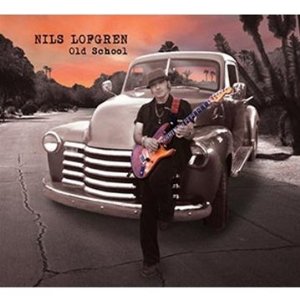
Vision Music, Inc.
Ah, Nils Lofgren: the little brother/blood brother/soul brother to scenes as varied as the sold-out stadium rock glory of Bruce Springsteen and the E Street Band to the dark, dark public wake known as Neil Young’s Tonight’s The Night album and the subsequent tour.
(Here’s a little trivia for you, boys and girls: how many shout-outs have been captured on Neil Young’s studio albums? Not too many that I know of. Sitting here, I can only come up with the moment just beyond the 3-minute mark in “Speakin’ Out” on Tonight’s The Night when Young calls out slightly off-mic: “All right, Nils” and Lofgren pulls the pin on a gut-wrencher of a guitar solo that sways from blistering bluesnarl to gentle harmonics and back. See if’n you can’t win yourself a glass of something good at the bar this holiday season with that little nugget of knowledge.)
And while he has provided six-string support in legendary settings over the years, Lofgren has also stood solidly on his own two feet as a solo artist. Lesser talents would have faded years ago, caught in the twilight zone of trying to pull off an early-70s-era Keith Richards impression for decades after the fact (even Keef himself couldn’t do that). But not Lofgren. “I ain’t no rock ‘n’ roll crook,” Lofgren sang on his self-titled solo album released in 1975, and indeed he wasn’t – and never has been. Lofgren’s been an original since the beginning, with the ability to write tunes that hook both the ear and the heart; sing them with a voice that’s always been as real as dirt; and back the whole package up with guitar playing that combines the rhythmic sensibility of the aforementioned Mr. Richards with the technical virtuosity of a Roy Buchanan. (Oh – those burbling finger-picked harmonics on an over-driven Strat!)
Which brings us to the latest release in a long line of Nils Lofgren solo albums: Old School. Not unlike John Hiatt, Lofgren’s songwriting has aged gracefully with him (and with all of us, as well). Having hit the 60-year-old mark this year, Lofgren is truly one of a rare breed of rock ‘n’ roll survivors who has made it this far with mind, talents, and wit intact. He can break your heart softly or let loose with a wall of Stratsquall that’s just as fiery as anything he did back in the 70s, but now the subject matter might be the titanium hips he had “hammered in” back in 2008; the mall-minds of today’s younger generation; or fallen heroes and peers.
Lofgren lays it down acoustic and sweet at times on Old School : “Let Her Get Away” is a reflection on a love lost that serves to pull a love known even closer; “When You Were Mine” is a pure and unblushing celebration of life; the cover of Bruce McCabe’s “Irish Angel” features Lofgren on keys and is so damn real it hurts; “I Miss You Ray” doesn’t try to go any deeper than the emotions of the title and doesn’t need to. And the reflections and questions of “Why Me” are built on unplugged underpinnings with bursts of electric guitar that explode over top of things like heat lightning across a summer night sky.
The gain and master volume are rolled on for the porch-stomp of “Amy Joan Blues” (Paul Rodgers guests on vox; Lofgren plays some absolutely nasty slide gee-tar). “Dream Big” stands tall on a majestic-sounding rhythm track, admonishing us all to “dream big/work hard/stay humble” and “give big/stay strong/be humble” while reminding us to “dance a lot,” as well. “Just Because You Love Me” is a proud declaration of love that was definitely inspired by the big band vibe of Lofgren’s E Street experiences. “Ain’t no old school anymore,” Lofgren and guest Lou Gramm tell us in the horn-punched romp of the title song, while the driving tune that follows advises that “60 Is The New 18”.
The album’s masterpiece may well be “Ain’t Too Many Of Us Left” featuring an appearance by legendary soul man Sam Moore on vocals – and an in-spirit cameo by ol’ Neil Young himself. It was Young’s phone call to Lofgren after his hip replacements that inspired the song: “Too many of us already gone to Heaven and Hell/So brother get well” was the message from Young. With great interplay between Lofgren and Moore on the choruses, “Ain’t Too Many” makes its case lyrically before giving way to a couple minutes of guitar work that are classic Nils Lofgren: bellowing runs that fetch in bent-string moans; wails that sound like they could easily wrench clear in lesser hands, but are completely under the control of Lofgren’s fingers; growling doublestops and phrases that “breathe” as if they’re being blown by a wild-assed free jazzman. As the song soars to its conclusion, Lofgren breaks into a knuckle-busting popping run that tumbles and cascades over top of itself; the drums and bass pick up on that same riff, the whole band turning into one big rhythm beast, driven by Lofgren’s guitar. Afterward, you’re left realizing that nobody – nobody – plays guitar like Nils Lofgren. Never did; still don’t.
Few artists can maintain their edge for decade after decade after decade without either turning into a cliché or making compromises of some sort. Nils Lofgren has done neither of those things and he’s still making fine, fine music.
Maybe there’s no old school any more, but no matter: play with your heart and it’ll stay real. Nils Lofgren’s Old School is living proof.



No Comments comments associated with this post